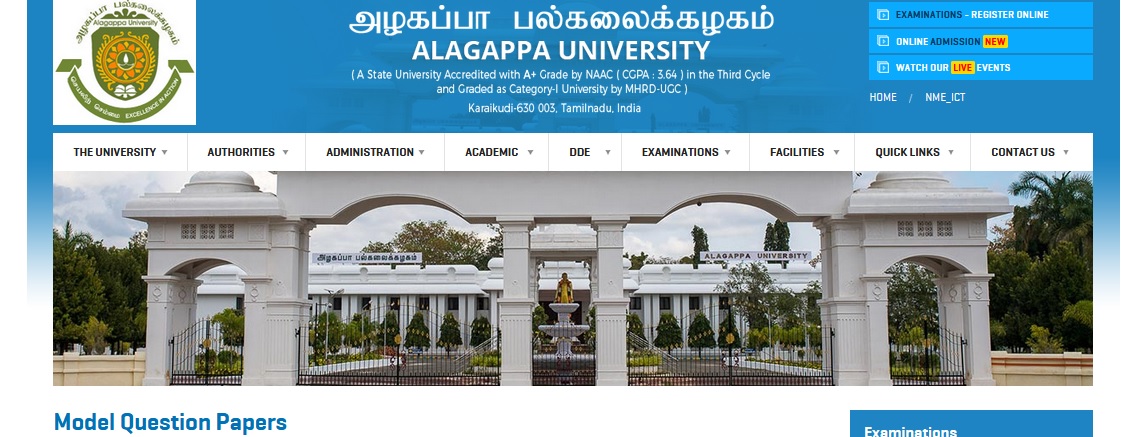International Marketing M.B.A Model Question Papers : alagappauniversity.ac.in
Name of the University : Alagappa University
Degree :M.B.A
Subject Code/Name : International Marketing
Document Type : Model Question Papers
Website : alagappauniversity.ac.in
Download Model/Sample Question Paper : Nov.2010 :https://www.pdfquestion.in/uploads/alagappauniversity.ac.in/4187.-MBA%28IB%20&%20E_COMMERCE%29.pdf
Alagappa International Marketing Question Paper
M.B.A. DEGREE EXAMINATION, NOVEMBER 2010
I B and E–Commerce
Time : 3 Hours
Maximum : 75 Marks
Related : Alagappa University Management Control And Information System M.B.A Model Question Papers : www.pdfquestion.in/4184.html
Answer all questions.
1. What is global marketing –
2. What is consumer decision-making –
3. What is national product –
4. Write a note on product positioning.
5. What is transfer pricing –
6. What is “Counter-trade” –
7. What product exhibition –
8. What is meant by prize coupon –
9. Who is a retailer –
10. What is P.O.P –

11. (a) State the need for good marketing environment.
(b) What is meant by consumer behaviour –
12. (a) Briefly explain the term ‘New Product’.
(b) What is meant by product positioning –
13. (a) State the significance of pricing strategies.
(b) What is counter trade – State its objects.
14. (a) Bring out the merits of personal selling.
(b) Distinguish between Advertising and Salesmanship.
15. (a) What are direct and indirect channels –
(b) State the objectives of trade fairs.
16. Explain the various approaches to the study of International-
17. Explain the product life cycle concept in global market.
18. Describe the payment procedures in global trades.
19. Explain the advertising media followed in
20. Discuss the importance and precautions of
M.B.A. DEGREE EXAMINATION, NOVEMBER 2010 :
Foreign Exchange Management
Time : 3 Hours Maximum : 75 Marks
Part – A (10 × 2 = 20)
1. Define Foreign Exchange.
2. Explain the term Direct Quotation.
3. What is Nominal Effective Exchange rate –
4. Explain the Crux of Asset Market Model.
5. What are Forward and Futures contracts –
6. What do you mean by the term “Swap Deal” –
7. What is Economic Exposure Risk –
8. What is Hedging –
9. What is European Option –
10. What do you mean by the terms netting and off setting –
11. (a) Who is FEDAI – State their functions.
(b) Explain different types of options trade.
12. (a) Explain the features of Purchasing Power Parity Theory.
(b) State the relevance of Interest Rate Parity
13. (a) Distinguish between Current Account
(b) Explain different types of Foreign Currency Accounts –
14. (a) State the features of future contract.
(b) What is option contract – State its types with their purpose –
15. (a) Explain the different types of currency swaps.
(b) Explain the procedure for extending or cancelling
16. Explain the different forms of quoting exchange
17. Describe the role of IMF in Exchange rate
18. What is meant by Transaction Exposure Risk –
19. Explain the need for different forms of Exchange
20. Describe the Economic consequences of exchange
M.B.A. DEGREE EXAMINATION, NOVEMBER 2010
Management Strategies Of MNCS
Time : 3 Hours Maximum : 75 Marks
Part – A (10 × 2 = 20)
1. Define MNC.
2. Define ‘Internationalization’.
3. What is Strategic Management –
4. What is SWOT Analysis –
5. What do you mean by Strategic Alliance –
6. Define Joint Venture.
7. What do you mean by Competitive Advantage –
8. What is market leadership –
9. What is Business Ethics –
10. What do you know about MNC Culture –
Part – B : (5 × 5 = 25)
Answer all questions :
11. (a) Briefly explain the emergence and growth of MNCs. (Or)
(b) Discuss briefly different types of MNCs.
12. (a) What is meant by BCG Matrix ? Explain giving suitable example. (Or)
(b) Explain different components of Strategies.
13. (a) Explain briefly the concept of Business Process Outsourcing with appropriate example. (Or)
(b) Critically examine international Strategic alliance giving suitable example.
14. (a) Explain the need and importance of Strategic Planning. (Or)
(b) Briefly explain environmental Scanning and Planning.
15. (a) Briefly explain organizational theories applicable to MNCs. (Or)
(b) Discuss briefly social responsibilities of MNCs.
Part – C : (3 × 10 = 30)
Answer any three questions :
16. Critically examine the benefits and problems posed by MNCs for the host and source country.
17. Discuss in detail different levels of strategies that the MNC can formulate.
18. Discuss different ownership strategies by which MNC can operate. Bring out the merits and limitations of each.
19. What do you mean by ‘Core Competence’ ? Explain the case of MNC having Core Competence.
20. Compare and contrast European and American organizational designs of MNCs.